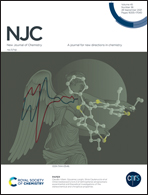Immobilization of dihydroflavonol 4-reductase on magnetic Fe3O4–PEI-pMaltose nanomaterials for the synthesis of anthocyanidins
Abstract
Anthocyanidins are flavonoids in plants with various biological activities and health-promoting effects. As plant-derived safe pigments, anthocyanidins have important economic values and broad applications. Dihydroflavonol 4-reductase (DFR) can catalyze dihydroflavonols into leucoanthocyanidins, which can turn into anthocyanidins through thermal incubation in n-butanol-HCl. However, studies on the enzymatic synthesis of anthocyanidins in vitro using recyclable nano-carrier immobilized enzymes have scarcely been seen until now. Here, we prepared magnetic Fe3O4–PEI-pMaltose nanoparticles and the recombinant DFR fusion enzyme with a maltose binding protein (MBP) tag. The DFR enzyme was immobilized on the Fe3O4–PEI-pMaltose nanoparticles based on the affinity adsorption under the optimum conditions of an enzyme/support ratio of 125 mg g−1, 20 °C, a pH of 6.5 and 25 min immobilization time. The sizes, morphologies, structures, and magnetic properties of the magnetic Fe3O4–PEI-pMaltose nanoparticles and the Fe3O4–PEI-pMaltose-immobilized DFR enzyme were characterized. The products from dihydroquercetin/dihydromyricetin catalyzed by the immobilized DFR enzyme or free DFR enzyme were both confirmed as cyanidin/delphinidin. Compared with the free DFR enzyme, the optimum reaction temperature and pH of the immobilized DFR enzyme were increased. The immobilized DFR enzyme possessed improved thermal and storage stabilities and enhanced tolerance to high pH conditions, and reduced the inhibitory effects of metal ions and organic solvents on the enzymatic activities. After four times repeated use, the activity of immobilized DFR remained above 85%.



 Please wait while we load your content...
Please wait while we load your content...